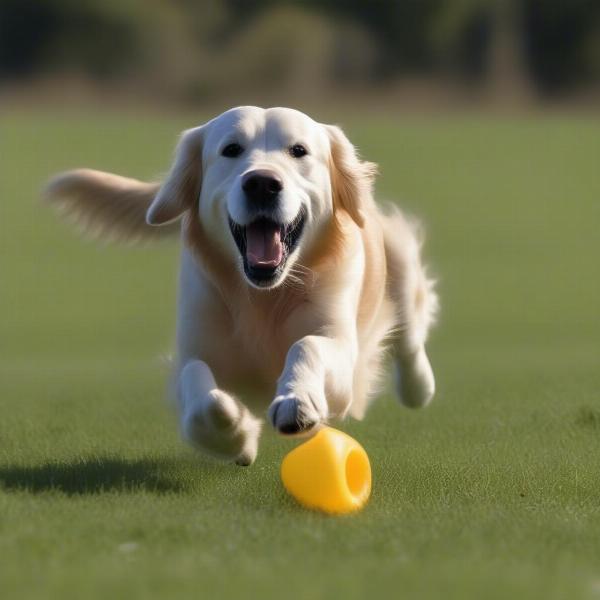Dog dummy toys are an invaluable tool for training and enriching the lives of our canine companions. Whether you’re preparing your dog for hunting, working on obedience, or simply looking for a way to keep them entertained, understanding how to choose and use a dog dummy is essential. From the basic puppy retrieving dummy to advanced scent training aids, this guide will cover everything you need to know about dog dummy toys.
Types of Dog Dummies and Their Uses
Choosing the right dog dummy depends on your dog’s age, breed, and training goals. There are a variety of options available, each designed for specific purposes:
- Canvas Dummies: These are a popular choice for beginners due to their soft texture and durability. They are ideal for puppies and dogs new to retrieving.
- Plastic Dummies: These are often used for water retrieving training as they float. They can also be weighted for more advanced exercises.
- Furred Dummies: These mimic the feel of real game, making them ideal for hunting dog training. They are available in various sizes and shapes to represent different animals.
- Scent Dummies: These are designed for scent work training. They can be impregnated with specific scents to help dogs develop their olfactory skills.
How to Introduce Your Dog to a Dummy
Introducing your dog to a dummy should be a positive and gradual process, especially for puppies. Start by letting your dog sniff and investigate the dummy. Encourage interaction with the dummy by making it exciting and rewarding, using praise and treats. You can also try tossing the dummy short distances and encouraging your dog to retrieve it.
Training with a Dog Dummy: Basic to Advanced Techniques
Once your dog is comfortable with the dummy, you can start incorporating it into training exercises. Here are some examples:
- Retrieve Training: Start with short retrieves and gradually increase the distance. Use positive reinforcement to encourage your dog to bring the dummy back to you.
- Scent Work: Hide the scent dummy and encourage your dog to find it. Start with easy hides and gradually increase the difficulty.
- Obedience Training: Use the dummy as a reward for completing other commands, such as sit, stay, and come.
- Advanced Retrieving: Introduce multiple dummies, different terrain, and distractions to challenge your dog’s retrieving skills.
 Dog Retrieving Dummy in a Field
Dog Retrieving Dummy in a Field
Choosing the Right Size and Weight
Choosing the appropriate size and weight of the dummy is crucial for your dog’s safety and training success. A dummy that is too heavy can strain a puppy’s developing joints, while a dummy that is too light may not be engaging for a larger dog. Consult with a professional trainer or veterinarian for guidance if you are unsure.
Caring for Your Dog’s Dummy Toys
Proper care and maintenance will ensure your dog’s dummy toys last longer. Clean the dummies regularly according to the manufacturer’s instructions. Check for any damage and replace any worn or torn dummies to prevent choking hazards.
What if My Dog Isn’t Interested in the Dummy?
Not all dogs take to dummy training immediately. Patience and persistence are key. Try different types of dummies, vary your training methods, and make the sessions fun and engaging. If you’re struggling, consider consulting a professional dog trainer.
Conclusion
Dog dummy toys are a versatile training tool that can help you build a strong bond with your dog while enhancing their physical and mental abilities. By choosing the right dummy and using effective training techniques, you can unlock your dog’s full potential and enjoy countless hours of fun and rewarding activities together. Remember to always prioritize your dog’s safety and well-being throughout the training process.
FAQ
- What age can I start using a dummy with my puppy? You can introduce a soft dummy to a puppy as early as a few weeks old, but formal retrieve training should typically begin around 6 months of age.
- Can I use a dog dummy for play? Yes, dog dummies can be used for play as well as training. They provide a great outlet for a dog’s natural retrieving instincts.
- How do I clean a dog dummy? Cleaning instructions vary depending on the material. Most canvas dummies can be washed in the washing machine, while plastic dummies can be wiped clean.
- My dog destroys dummies quickly. What should I do? Choose more durable dummies designed for heavy chewers or supervise your dog closely during training sessions.
- What if my dog swallows a piece of the dummy? Contact your veterinarian immediately if your dog swallows any part of a dog dummy.
- Can I make my own dog dummy? While you can make your own dummy, commercially available dummies are often designed with specific features for safety and durability.
- Are there any safety concerns with using dog dummies? Always supervise your dog when they are playing with or training with a dummy to prevent choking hazards.
Related Articles
About ILM Dog
ILM Dog is your one-stop resource for expert advice on all aspects of dog care and training. From breed selection to health and nutrition, we provide comprehensive and trustworthy information to help you raise a happy and healthy canine companion. We offer expert guidance on choosing the right breed for your lifestyle, understanding canine health and nutrition, and mastering effective training techniques. dog training dummy Contact us at [email protected] or +44 20-3965-8624 for personalized support.